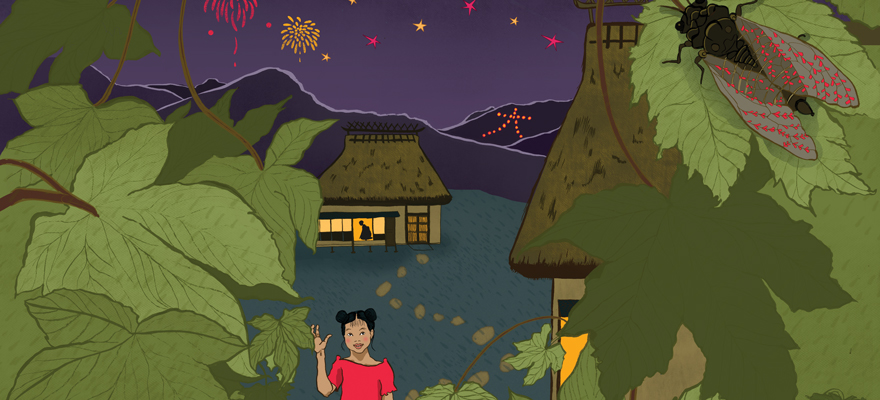Home > Highlighting JAPAN > Highlighting Japan August 2013 > Student's Corner
Highlighting JAPAN
Student's Corner
Obon

Let's explore the Japanese tradition of O-Bon! A tradition is a way of doing something that is handed down from older people to younger people. Traditions can be very old, or sometimes new. O-bon is very old.
Imagine yourself walking along a country lane in the early evening of late summer. Looking above the fiery orange of the setting sun you can see the faint sparkle of the stars in the darkening sky and the shadows of the hills to your right. The chirping sound of cicadas floats down from the hills and the smell of burning sticks, makibi, fills your nose.
Turning a corner, you find a small wood fire crackling and smoldering in a large dish on a stand. You have found a mukaebi or "welcoming fire". Next to the fire stands the gate to an old farmhouse. A small, neatly swept path leads up to the door. You gently push open the gate and carefully walk over each stone that leads to the porch. The dark shape of the tiled roof looms above you. Ringing the doorbell, soft footsteps can be heard inside. The door opens. Suddenly you see the smiling face of your Japanese friend Kaori. The sound of eating, drinking and people talking can be heard inside. Taking off your shoes, you walk along the corridor into the main room. Kaori's family and relatives are sitting on the floor around a long table, enjoying different dishes of food.
Match the English with the Japanese

Kaori explains that Japanese people often return to their family home during the O-bon season. O-bon lasts for 3 days, normally starting on the 15th of August. Because O-bon is so old, nobody really knows how it began. Many people believe that the ancestors of the family come back to the house at this time. Ancestors are all of the family members who were alive before. Kaori nudges your arm and jokes that she has so many ancestors there is not enough room in the house! Maybe you feel it's a little creepy. The ancestors are of course not alive, only their spirits can visit. Actually, the mukaebi helps them find their way from the family grave to the house. The time before O-bon is very busy, cleaning the house, garden and family grave in preparation for visitors, and for the family spirits.
Kaori points to a large wooden alter or chest. You can see the peaceful figure of Buddha sitting at the back of the chest, and in front, a special table with food arranged on it. This is a butsudan (Buddhist altar) says Kaori and the food on the table is called o-sonae. The spirits stay in the butsudan during O-bon. At the end of O-bon, an okuribi or "farewell fire" is lit, and the spirits return to the family grave. "We also visit our family grave, called O-haka mairi in Japanese, to ask our ancestors to help and protect us, and show them that they are remembered", says Kaori.
Kaori places an orange lantern in your hands. "This is a toro" she says. We light a candle in the toro and let it float down a stream or river on the last day of O-bon, which is called toro nagashi. The spirits follow the lanterns back to their world.
It's getting late. Kaori's mother hands you a small box of snacks from the dinner wrapped in a furoshiki, a traditional cloth. You thank her for her kindness and she and Kaori lead you to the door. "Just watch out for o-bake", Kaori says. "What are o-bake?" you ask. Kaori explains that they are strange spirits that come out at night. Promising to be careful, you make your way back down the country lane to the station. Almost tripping over a small stone statue in the darkness, you are lucky that you don't see the statue turn into a raccoon dog and run off... You just met your first O-bake!
© 2009 Cabinet Office, Government of Japan






